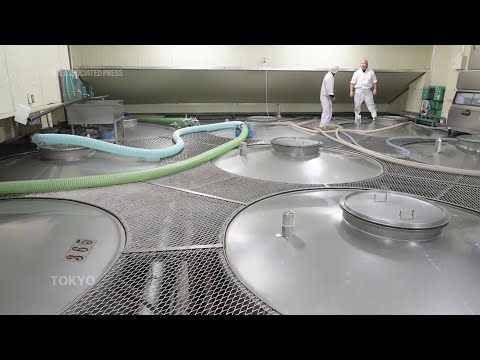(14 Nov 2024)
RESTRICTIONS SUMMARY:
ASSOCIATED PRESS
Tokyo – 14 November 2024
1. Various of facility for fermentation process
2. SOUNDBITE (Japanese) Hitoshi Utsunomiya, Director of Japan Sake and Shochu Makers Association:
++SOUNDBITE STARTS ON PREVIOUS SHOT AND IS OVERLAID BY SHOT 3++
“Sake brewing itself, using koji, is rare, and has continued for more than 1,000 years. It is also closely connected to the culture of Japanese life, and I think it is a treasure that Japan should continue to treasure in the future, as well as being a valuable source of cultural diversity to the world.”
3.The Chairman of Ozawa sake brewery, Junichiro Ozawa pointing out the current temperatures displayed for each tank at fermentation facility
4. Various of sake bottles left to mature
5. Samples of rice grain specifically produced for sake making (left), sample of polished grain for sake making (right)
6. Facility where rice grains are polished
7. SOUNDBITE (Japanese) Hitoshi Utsunomiya, Director of Japan Sake and Shochu Makers Association:
++SOUNDBITE STARTS ON SHOT 4 AND IS OVERLAID BY SHOT 5-6&8++
“One of the reasons why sake has become more popular around the world is due to the increase in the number of Japanese restaurants worldwide. I think sake also has an appeal that is different to wine and beer, so I hope that interest in sake as a new category of alcoholic beverage and food culture will grow, and that it will be combined with the cuisine of the country in which it is served."
8. Bottles of sake for tasting at Ozawa sake brewery
9. SOUNDBITE (Japanese) Kaori Ando, Tokyo resident:
++SOUNDBITE STARTS ON PREVIOUS SHOT AND IS OVERLAID BY SHOT 10++
(In reference to sake possibly being recognized as a UNESCO Intangible Cultural Heritage)
“Every year they make new sake. So I look forward to coming here around this time of the every year to try the new ones.”
10. bottles of sake for tasting at Ozawa sake brewery
STORYLINE:
Deep in a dark warehouse the sake sleeps, stored in rows of giant iron tanks, each holding more than 10,000 liters (2,640 gallons) of the Japanese rice wine – the product of brewing techniques dating back over 1,000 years.
Junichiro Ozawa, the 18th generation head of Ozawa Brewery, founded in 1702, hopes sake brewing will win recognition as a UNESCO Intangible Cultural Heritage, when the decision comes next month.
Sake, the drink of choice for the nobility in “The Tale of Genji” — Japan’s most celebrated work of literature — has been widening its appeal, boosted by the growing international popularity of Japanese cuisine.
Sake exports from Japan total over 41 billion yen ($265 million) a year, with the biggest destinations being the U.S. and China, according to the Japan Sake and Shochu Makers Association.
That’s up from about 22 billion yen in 2018. But exports still make up a tiny fraction of overall sake production in Japan. Brazil, Mexico and southeast Asia, as well as France and the rest of Europe, all places where Japanese restaurants are gaining popularity, are starting to take a liking to sake.
What’s key to sake making, which takes about two months, including fermentation and pressing, are the rice and the water.
For a product to be categorized Japanese sake, the rice must be Japanese. The relatively soft quality of fresh water in Japan, like the supplies provided by the two wells at Ozawa Brewery, is also critical.
Among Ozawa’s sake is the full-bodied aromatic Junmai Daiginjo, one of the top offerings, with 15% alcohol content and costing about 3,630 yen ($23) for a 720 milliliter bottle.
Find out more about AP Archive: http://www.aparchive.com/HowWeWork
Twitter: https://twitter.com/AP_Archive
Facebook: https://www.facebook.com/APArchives
Instagram: https://www.instagram.com/APNews/
You can license this story through AP Archive: http://www.aparchive.com/metadata/youtube/7bfeb9cf22a147bcafe8c866f16baffc
Author: AP Archive
Go to Source
News post in November 19, 2024, 9:00 am.
Visit Our Sponsor’s:
News Post In – News





